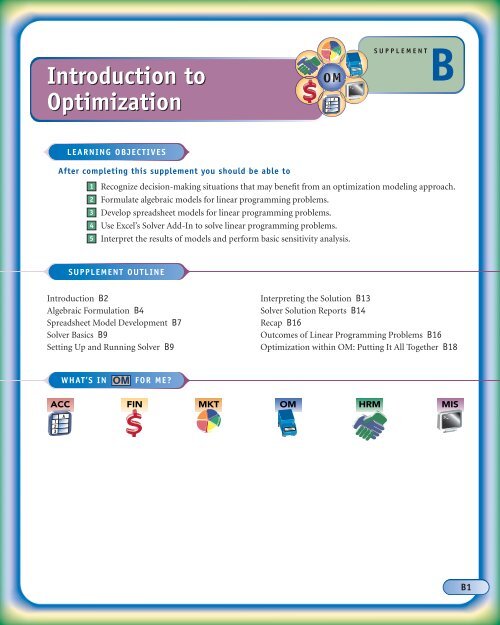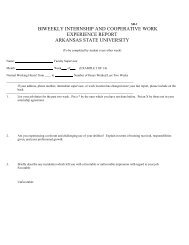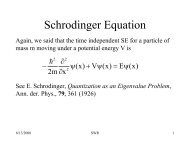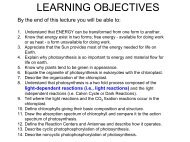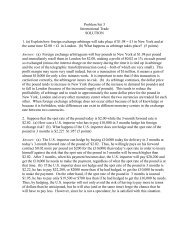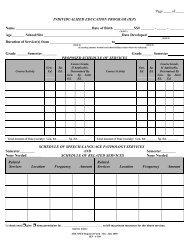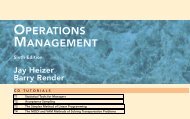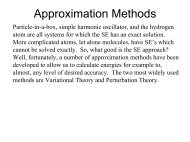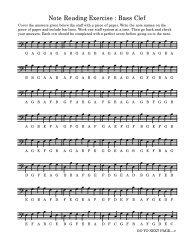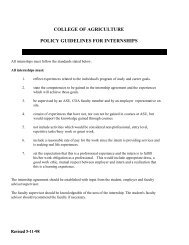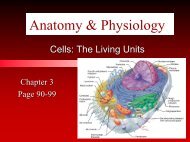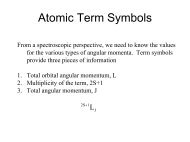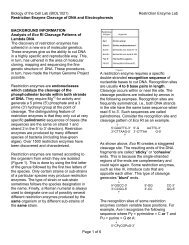Introduction to Optimization Introduction to Optimization
Introduction to Optimization Introduction to Optimization
Introduction to Optimization Introduction to Optimization
- No tags were found...
Create successful ePaper yourself
Turn your PDF publications into a flip-book with our unique Google optimized e-Paper software.
This chapter provides an introduction <strong>to</strong> optimization models and solution approaches.<strong>Optimization</strong> is a major field within the discipline of management science.The emphasis is on developing appropriate mathematical models <strong>to</strong> describe situations,implementing these models in a spreadsheet, using a spreadsheet-based solver<strong>to</strong> solve the optimization problems, and using human intelligence and judgment <strong>to</strong>interpret the results. We emphasize a particular type of optimization problem, calledlinear programming problems (or linear optimization). In linear programming (LP)problems, all of the relationships among the variables are linear.Think briefly about the allocation of study time mentioned in the opening paragraphs.In an optimization mindset, there is an objective you want <strong>to</strong> either maximizeor minimize, and there may be constraints within which you need <strong>to</strong> operate. Thereare also specific quantities, called decision variables, over which you have control.Therefore, this is termed a constrained optimization problem. A verbal statement ofthe study time problem might be that you want <strong>to</strong> maximize your grade point average.Constraints are a limited <strong>to</strong>tal amount of time <strong>to</strong> study and a desire <strong>to</strong> pass everycourse. Decision variables are the amounts of time allocated <strong>to</strong> each course. A morestructured statement of the problem isMaximize the objective: Grade point averageSubject <strong>to</strong> the constraints: Stay within available study timePass each course with a grade of at least CDecision variables: Amount of time <strong>to</strong> spend on each courseOur purpose is not <strong>to</strong> develop a formal mathematical model of the study time example.However, the actual process of thinking about a problem in a structured wayoften leads <strong>to</strong> insights you can use <strong>to</strong> make a better decision. You would probably thinkabout your current grade in each course, the remaining requirements of the course,and the amount of study time needed in order <strong>to</strong> at least pass each course. You mightalso think about how much time you would need <strong>to</strong> spend in order <strong>to</strong> get the best possiblegrade in each course. This structured thinking often leads <strong>to</strong> a better overall deciancmat02.qxd11/16/06 3:25 PM Page B2B2 • SUPPLEMENT BINTRODUCTION TO OPTIMIZATIONEveryone, almost daily, solves optimization problems in informal ways by usingmental models. If you have ever looked at a map when planning a trip and decidedupon a route <strong>to</strong> your destination <strong>to</strong> try <strong>to</strong> minimize either distance or time (or even <strong>to</strong>maximize scenic or recreational benefits), you have solved an optimization problem. Ifyou have ever been faced with <strong>to</strong>o much school work (i.e., studying for final examsand completing final projects) and a fixed amount of time, you have undoubtedlysolved an optimization problem that seeks <strong>to</strong> allocate the time available so that youwould, perhaps, maximize your grades in the various courses.Whereas informal optimization is done nearly every day by individuals, organizationscarry out formal optimization <strong>to</strong> assist in such decisions as product mix, pricing,scheduling, routing and logistics, supply chain management, facility location analysis,and financial planning and asset management. Many of these <strong>to</strong>pics are either directlyrelated <strong>to</strong> operations management or have strong connections <strong>to</strong> it. <strong>Optimization</strong> as adecision support <strong>to</strong>ol has applications across all functional areas of an organization.INTRODUCTION ObjectiveThe quantity <strong>to</strong> bemaximized or minimized. ConstraintsLimitations or requirementsthat must be satisfied. Decision variablesQuantities under the controlof the decision maker. Constrained optimizationproblemA mathematical modelin which one is trying <strong>to</strong>maximize or minimize somequantity, while satisfying aset of constraints.
ancmat02.qxd 11/16/06 3:25 PM Page B3INTRODUCTION • B3sion, even if a formal mathematical model is never developed. Even though this exampleis fairly simple, there are multiple fac<strong>to</strong>rs <strong>to</strong> consider when ultimately making thedecision. For example, if you spend the time required <strong>to</strong> get the best grade possible in aparticular course, does that jeopardize your ability <strong>to</strong> pass another class?The advantage of formal optimization modeling is that it can simultaneously considerthe effects of alternative decisions <strong>to</strong> produce the best overall decision according<strong>to</strong> the objective. Humans are capable of considering a few fac<strong>to</strong>rs simultaneously. Asthe size and complexity of a problem increase, humans cannot adequately keep inmind all of the effects of a decision. Large-scale optimization software can handlethousands or even millions of decision variables and constraints. Human intelligenceis still needed in the problem definition, or formulation, stage of problem solving andin the interpretation of the results of the computer solution. Computer algorithms arebest suited <strong>to</strong> taking a well-formulated problem definition and making the necessarycomputations <strong>to</strong> produce the best solution <strong>to</strong> that problem. In this chapter we focuson problem formulation, spreadsheet model development, solution with Solver, anExcel add-in, and interpretation of the results.The steps involved in solving optimization problems are shown in Figure B-1.These steps should be looked at as a guide.Steps Involved in Solving <strong>Optimization</strong> Problems•• Write the algebraic formulation of the problem.Define the decision variables.Write the objective function.• Write the constraints.Develop a spreadsheet model.Set up the Solver settings and solve the problem.•Understand the problem, perhaps by drawing a diagram which represents the problem.Write a problem formulation in words, including decision variables, objective function, andconstraints.Examine the results and make corrections <strong>to</strong> the model.FIGURE B-1Steps involved in solvingoptimization problems• Analyze and interpret the results. EXAMPLE B.1DJJ Enterprises manufactures au<strong>to</strong>motive parts. Two of these parts are camshafts and gears.Camshafts earn a profit of $25 per unit and gears earn $18 per unit. Three major resources are utilizedin the production process: steel, labor, and machine time. It takes 5 pounds of steel <strong>to</strong> make acamshaft, and 8 pounds <strong>to</strong> make a gear. Camshafts require 1 hour of labor; gears require 4 hours. Ittakes 3 hours of machine time per camshaft, and 2 hours per gear. For the current planning period,5000 pounds of steel, 1500 hours of labor, and 1000 hours of machine time are available. DJJ wouldlike <strong>to</strong> maximize profit during the current planning period, within allowable resources.Product MixDecision• Before You Begin: Deciding on how much of each product <strong>to</strong> produce (the product mix)is the focus of this problem. In order <strong>to</strong> formulate this problem, identify the objective function andthe profit associated with each product <strong>to</strong> be made and sold. Next, determine the constraints. Theconstraints limit resources. In this problem, there are limited amounts of steel, labor, and machinetime. Put the objective function and constraints in<strong>to</strong> a spreadsheet model and use Solver <strong>to</strong> find themaximum-profit product mix.
ancmat02.qxd 11/16/06 3:25 PM Page B4B4 • SUPPLEMENT BINTRODUCTION TO OPTIMIZATIONALGEBRAIC FORMULATION FormulationA formal, algebraic statemen<strong>to</strong>f a constrained optimizationproblem.The text description of the problem is fine for communicating a general understanding,but in order <strong>to</strong> address the problem using optimization we need <strong>to</strong> develop a formalalgebraic description, called a formulation. A formulation contains explicitdefinitions of the decision variables, an algebraic expression of the objective function,and algebraic statements of the constraints. This is not as hard as it sounds, but it is acrucial step if you hope <strong>to</strong> develop a high-quality spreadsheet model that Solver cansuccessfully solve.A diagram of the situation can help <strong>to</strong> structure the problem so that the algebraicformulation can be written down more easily. A well-constructed diagram is also avaluable communication <strong>to</strong>ol. In this situation, three resources are combined <strong>to</strong> producetwo products. Specific amounts of each resource are needed, and each productgenerates a known profit. See Figure B-2 for one way <strong>to</strong> show this. One of the importantpoints is that the <strong>to</strong>tal amount of each resource available must be shared betweenthe two products (assuming both are <strong>to</strong> be produced).A diagram, coupled with a text-based formulation, often serves as a valuable steppings<strong>to</strong>ne <strong>to</strong> a formal algebraic formulation. In this situation, a text-based formulationcan be stated as follows:Text-Based Formulation● Decision variables: Number of camshafts <strong>to</strong> make, number of gears <strong>to</strong> make● Objective function: Maximize profit● Constraints: Must not exceed our resource availability in steel, labor, and machinehoursThe text-based formulation helps <strong>to</strong> structure the problem. The next step is <strong>to</strong>write the algebraic formulation. The algebraic formulation states the decision variables,objective function, and constraints in algebraic terms. The decision variablescorrespond <strong>to</strong> the quantities of camshafts and gears <strong>to</strong> make. We do not know aheadof time the best values for these (that’s what we’re trying <strong>to</strong> determine), so we create avariable <strong>to</strong> represent each quantity, as follows:FIGURE B-2DJJ Enterprises diagramRawMaterialsLaborMachineTime5 lb8 lb1 hr 3 hr 4 hr 2 hrCamshafts($25/unit)Gears($18/unit)
ancmat02.qxd 11/16/06 3:25 PM Page B5Decision VariablesC number of camshafts <strong>to</strong> makeG number of gears <strong>to</strong> makeThe actual names of the decision variables are not crucial (some people prefer X 1 andX 2 , for example); however, it is helpful <strong>to</strong> name the variables so the names remind youof the quantities they represent.The next step is <strong>to</strong> write the objective function in terms of the decision variablesjust defined. The objective function is simply an expression that determines howmuch profit will be earned if C camshafts are made and G gears are made. We also indicatewhether we want <strong>to</strong> maximize (“Max”) or minimize (“Min”) the objectivefunction. Since we know the unit profits of each, the objective function isALGEBRAIC FORMULATION • B5Objective FunctionMax 25C 18G (profit, $)It is good practice <strong>to</strong> include the units and the quantity represented by the objectivefunction, as shown in parentheses.Finally, we need <strong>to</strong> write expressions for the constraints. In this example, we arelimited by the amounts of the resources—steel, labor, and machine time—available.For steel, we know that 5000 pounds are available. We also know that each camshaftuses 5 pounds, and each gear uses 8 pounds. Therefore, if we make C and G camshaftsand gears, respectively, it will require 5C 8G lb of steel. In order for this product mix<strong>to</strong> be possible, this combined <strong>to</strong>tal must not exceed 5000 pounds. We write this inmathematical terms as follows:5C 8G 5000 (steel, lb)Using similar logic, we write the constraints for labor and machine time. Convinceyourself that these constraints should be written as1C 4G 1500 (labor, hr)3C 2G 1000Each of these constraints is a less-than-or-equal-<strong>to</strong> constraint. A constraint canalso be a greater-than-or-equal-<strong>to</strong> constraint or an equality constraint. A problemcan have a mix of these constraint types. For example, it could be that we are required<strong>to</strong> produce at least a certain number of camshafts and gears combined ( constraint).Alternatively, perhaps we want <strong>to</strong> force our solution <strong>to</strong> use exactly 1500 labor hours( constraint). Strict inequalities (, ) are not used in optimization problems; thethree constraint relationship types are , , and .There are two additional constraints that initially may not seem required. Theyforce each of the decision variables <strong>to</strong> remain nonnegative, that is, greater than orequal <strong>to</strong> zero. We refer <strong>to</strong> these as the nonnegativity constraints. From a businesssense we know that we cannot produce negative quantities of camshafts and gears.However, neither a mathematical model nor a spreadsheet model “knows” these seeminglyobvious things. These constraints are written:C 0G 0(machine time, hr)Most of the time, these would be written <strong>to</strong>gether asC, G 0 (nonnegativity) Less-than-or-equal-<strong>to</strong>constraintA constraint such as 3x 1 5x 2 22, often used <strong>to</strong> modela limitation on the amount ofa resource that can be used. Greater-than-or-equal-<strong>to</strong>constraintA constraint such as 4x 1 7x 2 50, often used <strong>to</strong>model a requirement thatmust be satisfied. Equality constraintA constraint such as 6x 1 3x 2 30, used <strong>to</strong> specifythat a requirement mustbe met exactly. Nonnegativity constraintsConstraints of the form x 1 0, which are nearly universal inlinear programming problems.They are used <strong>to</strong> represent thefact that negative quantities ofproducts cannot be made,shipped, etc.
ancmat02.qxd 11/16/06 3:25 PM Page B6B6 • SUPPLEMENT BINTRODUCTION TO OPTIMIZATIONPutting all the constraints <strong>to</strong>gether, we haveConstraintsNormally, we consolidate the entire formulation <strong>to</strong>gether in<strong>to</strong> a standard format, asfollows:Complete Formulation5C 8G 5000 (steel lb)1C 4G 1500 (labor, hr)3C 2G 1000 (machine time, hr)C, G 0 (nonnegativity)Decision variables:C number of camshafts <strong>to</strong> makeG number of gears <strong>to</strong> makeMax: 25C 18G (profit, $)Subject <strong>to</strong> (or, “s.t.”):5C 8G 5000 (steel, lb)1C 4G 1500 (labor, hr)3C 2G 1000 (machine time, hr)C, G 0 (nonnegativity) Linear program (LP)A constrained optimizationproblem in which all thefunctions involving decisionvariables are linear. Feasible solutionA specific combinationof values of the decisionvariables such that all ofthe constraints are satisfied. Infeasible solutionA specific combinationof values of the decisionvariables such that at leas<strong>to</strong>ne of the constraints isviolated. Optimal solutionThe feasible solution with thelargest (for a maximizationproblem) or smallest (for aminimization) objectivevalue.Examining the FormulationThe formulation is a concise mathematical description of the problem. It indicatesthat we want <strong>to</strong> find the values of C and G that produce the largest value of the objectivefunction while satisfying all the constraints. In this formulation all of the relationshipsamong the variables are linear. That is, all expressions involving thevariables C and G consist of a constant multiplied by the variable itself. Combinationsof variables can be added (or subtracted) <strong>to</strong> one another, but there are nononlinear expressions involving variables, such as C 2 , G/C, or C. Thus, this formulationis referred <strong>to</strong> as a linear program (LP), or an LP formulation. A linearprogram (LP) is an optimization problem in which all of the relationships amongthe decision variables are linear. LPs are much easier <strong>to</strong> solve, in general, thanproblems involving nonlinear expressions. The solver built in<strong>to</strong> Excel has the capability<strong>to</strong> solve both linear and nonlinear problems, but if your problem can be formulatedas an LP, it is best <strong>to</strong> do so because its solution algorithm is faster andmore reliable.A feasible solution <strong>to</strong> an optimization problem in general, or an LP as in this case,is a particular combination of C and G that satisfies all of the constraints. An infeasiblesolution violates at least one of the constraints. The optimal solution is the feasiblesolution with the largest (for a “max” problem) or smallest (for a “min” problem)objective function value.Consider the solution C 75, G 200. Is this solution feasible? To determine if itis, evaluate each of the constraints. The amount of steel required would be 5(75) 8(200) 1975 lb, which is less than the 5000 pounds available. Similarly, the solutionrequires 1(75) 4(200) 875 hr labor (less than the 1500 hours available), and
ancmat02.qxd 11/16/06 3:25 PM Page B7SPREADSHEET MODEL DEVELOPMENT • B73(75) 2(200) 625 hr machine time. Both C and G are nonnegative, so this solutionis feasible. Now consider C 300, G 200. Verify that this solution requires3100 pounds steel, 700 hours of labor, and 1300 hours of machine time. Is the solutionfeasible? It satisfies two of the constraints, but violates the machine time constraint.Therefore, this solution is infeasible. The point is that if a solution violateseven a single constraint, the solution is infeasible.Is either one of these solutions the optimal solution? The second solution, C 300and G 200, cannot be optimal because it is not even feasible. The first solution,C 75 and G 200, is at least feasible. Actually, it is one of an infinite number offeasible solutions <strong>to</strong> this problem. However, it is not the optimal solution. You can try<strong>to</strong> find a better feasible solution. In fact, for this small problem, you could probably,using pencil, paper, and a calcula<strong>to</strong>r, find the optimal solution. If the problem werelarger, perhaps with 15 products and 8 constraints, finding the optimal solution bytrial-and-error would be nearly impossible.An ingenious algorithm has been developed <strong>to</strong> solve LPs. It is called the SimplexMethod and was developed by George Dantzig in 1947. Improvements have beenmade in solving large LPs since then, but the Simplex Method is still the most commonmethod for solving them. Learning the intricacies of the Simplex Method is asignificant study in itself. Fortunately, Solver, part of Microsoft Excel, implements theSimplex Method. The user does not need <strong>to</strong> learn the details of the mathematical manipulations,but can focus on developing a high-quality spreadsheet model from analgebraic formulation before setting up the problem in Solver. Once Solver is able <strong>to</strong>find the optimal solution, the user can perform additional analysis <strong>to</strong> gain insight in<strong>to</strong>the business problem. Simplex MethodA mathematical algorithmdeveloped by George Dantzigthat, when implemented insoftware, can solve LPs veryquickly.SPREADSHEET MODEL DEVELOPMENTNow that an algebraic formulation has been developed, we will implement the formulationin the spreadsheet. There is no single way <strong>to</strong> set up an LP in a spreadsheet, butthere are some guidelines that can be established:● Develop a correct, flexible, and documented model, as described in SupplementA. The user should be able <strong>to</strong> use the model in a “what-if” manner, changingany decision variable or coefficient in the model without having <strong>to</strong> change anyformulas.● Divide the worksheet in<strong>to</strong> three sections: one for the decision variables, one forthe objective function, and one for the constraints.● Use the algebraic formulation and the natural structure of the problem <strong>to</strong> guidethe structure of the spreadsheet.● Use one cell for each decision variable.● S<strong>to</strong>re the coefficients of the objective function in separate cells, and use anothercell <strong>to</strong> s<strong>to</strong>re a formula that calculates the value of the objective function (by referring<strong>to</strong> the decision variable cells and the coefficient cells).● Likewise, s<strong>to</strong>re the coefficients of the constraints in cells, and write formulas <strong>to</strong>compute the “left-hand-side” (LHS) value of each constraint. The LHS value isthe value of the constraint expression <strong>to</strong> the left of the , , or sign. Thens<strong>to</strong>re the “right-hand-side” value (RHS value) of each constraint next <strong>to</strong> this formulafor easy comparison. LHS valueThe value of the constraintexpression <strong>to</strong> the left of the, ,or sign. RHS valueThe value of the constraintexpression <strong>to</strong> the right of the, ,or sign.
ancmat02.qxd 11/16/06 3:25 PM Page B8B8 • SUPPLEMENT BINTRODUCTION TO OPTIMIZATIONA spreadsheet for this problem is shown in Figure B-3. It uses C 75 and G 200as trial values. Note the structure of the model: column A is used for text labels,columns B and C are used <strong>to</strong> represent camshafts and gears, respectively, and columnsD–F are used <strong>to</strong> compute formulas and show the resource limitations. There is a row(row 5) reserved <strong>to</strong> contain the decision variables, a row (row 8) <strong>to</strong> s<strong>to</strong>re the coefficientsand compute the value of the objective function, and one row for each of theconstraints (rows 11–13). As in Supplement A, values highlighted in yellow representdata provided with the problem, and the light blue cell represents the primary outputmeasure, the objective function. In addition, green cells represent the decision variables.Cells B5:C5 contain values of the decision variables. The user can change these <strong>to</strong>see the effects of different solutions, visually checking <strong>to</strong> see if the constraints are satisfied.Cells B8:C8 contain the objective function coefficients, in this case, the unitprofits. Cells B11:C13 contain the coefficients of the constraints. Refer <strong>to</strong> the algebraicformulation given previously. The first constraint is 5C 8G 5000. The coefficientsare 5 and 8, meaning that 5 lb of steel are required for each camshaft, and 8 lb of steelare required for each gear. In cell F11, the value 5000 is s<strong>to</strong>red.The formula in cell D8 is B8*B$5C8*C$5. This references the objective coefficients(B8:C8) and the decision variables (B5:C5) <strong>to</strong> compute the <strong>to</strong>tal profit. If eithera decision variable or a coefficient changes, the <strong>to</strong>tal profit will still calculate properly.Copy this formula <strong>to</strong> cells D11:D13 <strong>to</strong> compute the LHS values of the constraints, thatis, the actual resources used by the solution. You could also write three additional formulasin cells D11:D13, but using absolute and relative references allows you <strong>to</strong> writeone formula and copy it <strong>to</strong> other cells needing formulas. Cell D11 computes theamount of steel used by the current solution. A sign is entered in<strong>to</strong> cell E11 forreadability, and the RHS value is entered in F11.Testing the ModelAfter the base-case model is developed, you should enter some trial values in<strong>to</strong> thecells as decision variables in order <strong>to</strong> check the model’s calculations. The trial solutionshown in Figure B-3 is the same solution we discussed when defining feasible and infeasiblesolutions. Note that the spreadsheet calculates $8800 profit, 3300 pounds steelused, 1500 hours labor used, and 1000 hours machine time used. These values matchthose noted previously. We can quickly see from the model that this is a feasible solutionby observing that the values in cells D11:D13 are all the values in cells F11:F13.FIGURE B-3Spreadsheet for DJJ problem12345678910111213A B C D E F GExample B.1DJJ Enterprises Production PlanningDecision Variables Camshafts GearsUnits <strong>to</strong> Make 75 200ObjectiveTotalProfit $25 $18 $5,475D8: =B8*B$5+C8*C$5(copied <strong>to</strong> D11:D13)Constraints Used AvailableSteel (lb) 5 8 1975
ancmat02.qxd 11/16/06 3:25 PM Page B9If the spreadsheet model is larger, the model testing phase is more involved. Findingerrors in spreadsheet models is generally not easy, which makes this step especiallyimportant. No matter how much a spreadsheet has been used, you should alwaysthink about the outputs generated by a model <strong>to</strong> see if they make sense given yourknowledge of the situation. Excel has <strong>to</strong>ols available <strong>to</strong> help diagnose problems inmodels. These are Error Checking (Tools/Error Checking) and Formula Auditing(Tools/Formula Auditing). These are not demonstrated in this supplement, but everyspreadsheet modeler should be familiar with them.SETTING UP AND RUNNING SOLVER • B9Given the spreadsheet model, you could use it <strong>to</strong> try out different solutions. As we sawpreviously, it is easy <strong>to</strong> tell whether a solution is feasible. Therefore, through some trialand error, you could most likely find the optimal solution <strong>to</strong> this problem. Since thereare only two decision variables, this probably will not take you long. However, for alarger problem, finding the optimal solution using this approach would at best takemuch longer, and most likely you would never find the optimal solution.Excel’s Solver add-in solves optimization problems. An add-in is an additionalpiece of software that enhances Excel’s core capabilities. By default, Solver does notload au<strong>to</strong>matically when Excel starts. To load Solver, go <strong>to</strong> Tools/Add Ins and selectSolver from the list that appears. If this is the first time you have used Solver on yourmachine, you may be prompted <strong>to</strong> insert your Microsoft Office CD so that the Solversoftware can be copied on<strong>to</strong> your hard disk. Once you have selected (and possibly installed)Solver from the Add Ins list, it will au<strong>to</strong>matically be loaded every time Excelstarts until you deselect it from the Add Ins list.SOLVER BASICSProblem-Solving Tip: Solver Is Not in the Add Ins List If you are using Excel 2000 or later, Solvershould appear on the Add Ins list when you select Tools/Add Ins. The first time you run Solver, youmay be prompted <strong>to</strong> insert your Microsoft Office CD. You will only need <strong>to</strong> do this once. If you areusing Excel 97 or earlier, Solver does not necessarily appear in the Add Ins list. If it does not, you willneed <strong>to</strong> first quit Excel and run the Microsoft Office Setup program from the Microsoft Office CD.Follow the on-screen prompts <strong>to</strong> install Solver.SETTING UP AND RUNNING SOLVERTo set up Solver for the DJJ problem, choose Tools/Solver from the menu. A dialogbox similar <strong>to</strong> the one shown in Figure B-4 appears. Setting up an optimization problemwith Solver consists of four steps:1. Specify the Target Cell (corresponds <strong>to</strong> the objective function in the algebraicmodel).2. Specify the Changing Cells (corresponds <strong>to</strong> the decision variables in the algebraicmodel).3. Specify the Constraints.4. Specify Solver Options.These steps are easy if you have previously completed the algebraic formulation andspreadsheet model. They are very difficult, and perhaps impossible, if you haven’t.Most difficulties students have with Solver are not really with Solver, but arise because Target CellIn Solver, the cell <strong>to</strong> bemaximized or minimized.This cell corresponds <strong>to</strong> theobjective value. Changing CellsIn Solver, the cells thatcan be changed during theoptimization process. Thesecells correspond <strong>to</strong> thedecision variables. ConstraintsIn Solver, the limitationsand requirements that mustbe met.
ancmat02.qxd 11/16/06 3:25 PM Page B10B10 • SUPPLEMENT BINTRODUCTION TO OPTIMIZATIONFIGURE B-4Solver Parameters box (empty) Solver OptionsSolver provides many optionsfor the solution process. ForLPs, the two most commonlyused are Assume LinearModel and Assume Non-Negative.they either have not fully unders<strong>to</strong>od the problem or developed an algebraic formulationor have not developed a correct and flexible spreadsheet model.The Target Cell is the cell that you want <strong>to</strong> maximize or minimize. That is, it representsthe objective value of the model. In this example, cell D8 calculates the profit obtainedfrom some combination of camshafts and gears. The Target Cell must alwayscontain a formula; otherwise Solver generates an error message. To specify D8 as theTarget Cell, either click on cell D8 directly or type “D8” in<strong>to</strong> the Target Cell field. Thenmake sure the radio but<strong>to</strong>n on the “Equal To” line is set <strong>to</strong> “Max.” There are threechoices on this line, but we will only deal with maximizing and minimizing problems.Click in the “By Changing Cells” field. The Changing Cells represent the decision variablesof the model—in our case, the numbers of camshafts and gears. These values ares<strong>to</strong>red in cells B5 and C5. The easiest way <strong>to</strong> enter these in<strong>to</strong> the By Changing Cellsfield is <strong>to</strong> simply select them directly in the spreadsheet using either the mouse <strong>to</strong> selectboth cells or by clicking on one cell, holding down the Shift key, and then usingthe keyboard arrow keys <strong>to</strong> select all of the pertinent cells. Alternatively, the range“B5:C5” can be typed directly in the dialog box. The Solver Parameters box <strong>to</strong> thispoint is shown in Figure B-5. Note that if you type in the cell references directly forthe Target Cell and the Changing Cells, you do not have <strong>to</strong> type in the “$” characters.This is one feature where it doesn’t matter if you use absolute or relative cell referencing(see Supplement A for more information on absolute and relative references).Entering the constraints is slightly more complicated, but not difficult if thespreadsheet model is designed well. To enter a constraint, click the “Add” but<strong>to</strong>n. Abox appears, as shown in Figure B-6. A constraint in Solver consists of three pieces ofFIGURE B-5Solver Parameters box (partiallycomplete)
ancmat02.qxd 11/16/06 3:25 PM Page B11SETTING UP AND RUNNING SOLVER • B11FIGURE B-6Add Constraint box (empty)information: a “Cell Reference,” which should refer <strong>to</strong> a spreadsheet cell containing aformula; a relationship opera<strong>to</strong>r, which can be , , or ; and a “Constraint,” whichshould refer <strong>to</strong> a spreadsheet cell containing a value. More specifically, a constraint isof the formLHS Cell {, , or } RHS CellConsider our first constraint, dealing with steel. The algebraic form of this constraint is5C 8G 5000 (steel, lb)and is implemented in row 11 of the spreadsheet. Cells B11 and C11 s<strong>to</strong>re the coefficients,cell D11 contains the formula “B11*B$5C11*C$5,” cell E11 contains the relationship, and cell F11 contains the value 5000. How do we fill in the Add Constraintbox in Figure B-6? Since cell D11 computes the amount of steel actually usedby a given combination of camshafts and gears, D11 is the “LHS Cell” for the constraint.Similarly, since F11 contains the amount of steel available, it is the “RHS Cell”for the constraint. The completed Add Constraint box is shown in Figure B-7.We have two other constraints <strong>to</strong> enter, so click “Add” on the Add Constraint box. Ifyou have already clicked “OK,” then simply click “Add” on the Solver Parameters box.The other two constraints are entered in exactly the same way. They are both constraints.Using the previous logic, these constraints should be entered asD12 F12D13 F13Once you have entered the last constraint, click “OK” on the Add Constraint box. Thecompleted Solver Parameters box is shown in Figure B-8.Problem-Solving Tip: What if some of the constraints are or constraints? Most problemscontain more than one type of constraint. For these, simply pull down the arrow at the center of theAdd Constraint box and change the relationship <strong>to</strong> either or , as appropriate. There are two additionalchoices, “int” and “bin” (not shown in the figures). These choices are for problems with integerand binary variables, which are beyond the scope of this example. They represent a special typeof restriction on the decision variables.FIGURE B-7Add Constraint box (complete)
ancmat02.qxd 11/16/06 3:25 PM Page B12B12 • SUPPLEMENT BINTRODUCTION TO OPTIMIZATIONFIGURE B-8Solver Parameters box (complete)We have completed the first three steps of specifying the problem <strong>to</strong> Solver. Tocomplete the fourth step, click the “Options” but<strong>to</strong>n on the Solver Parameters box. Onthe resulting Solver Options dialog box, select “Assume Linear Model” and “AssumeNon-Negative,” as shown in Figure B-9. Don’t worry about or change any of the otheroptions. Once you have done this, click “OK” <strong>to</strong> return <strong>to</strong> the Solver Parameters box.The Assume Non-Negative option adds the requirement that each of the ChangingCells be 0. This specifies our requirement in the algebraic formulation that C 0and G 0. The Assume Linear Model option tells Solver <strong>to</strong> use the Simplex Method,mentioned previously. Solver actually comprises two solution algorithms, the SimplexMethod (for linear programming problems) and a more general solution algorithmthat can solve both linear and nonlinear problems. For linear programming problems,the Simplex Method is much faster and more reliable than the more general algorithm.It also provides more sensitivity analysis information.Solving the ProblemThe problem has now been completely specified. To actually solve it, click “OK” on thecompleted Solver Parameters box. Solver then applies the algorithm <strong>to</strong> the problemFIGURE B-9Solver Options box (complete)
ancmat02.qxd 11/16/06 3:25 PM Page B13and produces a completion message, as shown in Figure B-10. The values of theChanging Cells (and any other cells dependent on them) also will change in themodel. It is very important <strong>to</strong> read the Solver Results box. This one says “Solver founda solution. All constraints and optimality conditions are satisfied.” If you did not obtainthe same message for this problem, you should go back and work through theproblem again, making sure each step is followed carefully. This message essentiallymeans that Solver was successful in finding the optimal solution, and the solutionshown in the spreadsheet is guaranteed <strong>to</strong> be the optimal solution <strong>to</strong> the model. Thereare many possible messages for the Solver Results box. Later we discuss some of themore commonly encountered ones and their meanings. You may notice that you cangenerate reports (Answer, Sensitivity, and Limits) from this dialog box as well. Thesereports can help you understand more about the solution and generate additional insightsin<strong>to</strong> the business problem. These are discussed later.INTERPRETING THE SOLUTION • B13As shown in Figure B-11, the optimal solution is <strong>to</strong> make 100 camshafts and 350 gears.Doing so will yield a profit of $8800 and will require 3300 pounds of steel, 1000 hoursof labor, and 1000 hours of machine time. Notice that we don’t use all the steel that isavailable. In fact, there are 1700 pounds of steel unused. However, all of the labor andmachine time is used. Having steel left over might seem nonintuitive, but making moreof either camshafts or gears (<strong>to</strong> use up more steel) would also require more labor andmachine time, of which we have no extra. Therefore, we are at a limit of sorts in howfar we can “push” this solution. In general, if we have more constraints than decisionvariables, there will some constraints that are not at their limits. Constraints at theirINTERPRETING THE SOLUTIONFIGURE B-10Solver Results box12345678910111213A B C D E FExample B.1DJJ Enterprises Production PlanningDecision Variables Camshafts GearsUnits <strong>to</strong> Make 100 350ObjectiveTotalProfit $25 $18 $8,800Constraints Used AvailableSteel (lb) 5 8 3300
ancmat02.qxd 11/16/06 3:25 PM Page B14B14 • SUPPLEMENT BINTRODUCTION TO OPTIMIZATION Binding constraintsConstraints that are satisfiedexactly at the optimalsolution. Nonbinding constraintsConstraints that are satisfiedat the optimal solution, but asstrict inequalities ( or ). SlackThe difference between theleft-hand side and the righthandside of a constraint.Loosely speaking, the amoun<strong>to</strong>f a resource left over (for a constraint) or the amountby which a requirement issatisfied (for a constraint).limits when at the optimal solution, that is, with the LHS value equal <strong>to</strong> the RHS value,are called binding constraints. Those that are not at their limits are called nonbindingconstraints. Here the binding constraints are labor and machine time, and the nonbindingconstraint is steel. As noted, we have 1700 pounds of steel remaining at this solution.This value is called the slack of the constraint and is simply the differencebetween the RHS value and the LHS value (slack values for binding constraints areequal <strong>to</strong> 0). This is a fundamental insight gained from the solution. Before solving theproblem, we didn’t know that labor and machine time would run out, in a sense, beforesteel. Putting this situation in<strong>to</strong> practical business terms, if we want <strong>to</strong> do even betterthan this optimal solution, we will need <strong>to</strong> address the resource limitations of laborand/or machine time or find another use for the excess steel.In specifying the model <strong>to</strong> Solver, we must be careful <strong>to</strong> retain the flexibility of themodel. This is done in Solver by using only cell references, not specific values. Now wehave a powerful <strong>to</strong>ol for analysis of the problem. We can change any parameter valuein the model (any value highlighted in yellow), go <strong>to</strong> Tools/Solver, and click “OK.”Solver remembers all the problem settings, so we don’t need <strong>to</strong> reenter them. For example,if we have more labor and/or machine time available, we can enter the newvalue(s) in cell F12 and/or F13, run Solver again, and immediately see the impact ofthe modified resource amount. More importantly, we should do this before we actuallycommit <strong>to</strong> paying overtime for labor or committing more machine time; this waywe can determine if, indeed, it is worthwhile. This ability <strong>to</strong> immediately reoptimizethe problem is extremely powerful and can lead <strong>to</strong> additional insights <strong>to</strong> assist in decisionmaking.SOLVER SOLUTION REPORTSThree reports are available when Solver has successfully found an optimal solution.These are the Answer Report, the Sensitivity Report, and the Limits Report. They areshown as choices when Solver completes its work and displays the Solver Results box(Figure B-10). To generate these reports, select them and then click “OK.” Solver insertsthree new worksheets in the workbook. A detailed discussion of these reports isbeyond the scope of this chapter, but an overview is provided of the Answer and SensitivityReports. Refer <strong>to</strong> one of the management science texts listed at the end of thissupplement for more detailed information.The Answer Report for this problem is shown in Figure B-12. It contains three sections,one each for the Target Cell, Adjustable (Changing) Cells, and the Constraints.Shown in this report are the “original” and “final” values. The original values are thevalues that were in the cells when Solver started its calculations, and the final valuesare the optimal values. By looking at the Target Cell and Adjustable Cells sections, youcan identify that the optimal solution contains 100 camshafts and 350 gears and yields$8800 in profit. The Constraint section contains the cell value (the LHS value) of theconstraint, the actual constraint itself as specified <strong>to</strong> Solver (the “Formula” column inthe report), whether the constraint is binding or nonbinding, and the slack value. Twoconstraints are shown as binding, as we have already discovered by analyzing the solutionin the spreadsheet.The Answer Report doesn’t provide any new information compared <strong>to</strong> what isavailable from an analysis of the final spreadsheet. However, it puts the informationin<strong>to</strong> a standard format. If two people develop spreadsheets for the same problem, theywill likely look different. However, if the models are set up and solved correctly, the
ancmat02.qxd 11/16/06 3:25 PM Page B15SOLVER SOLUTION REPORTS • B15Target Cell (Max)Cell Name Original Value Final Value$D$8 Profit Total $0 $8,800Adjustable CellsCell Name Original Value Final Value$B$5 Units <strong>to</strong> Make Camshafts 0 100$C$5 Units <strong>to</strong> Make Gears 0 350FIGURE B-12Answer Report for DJJEnterprisesConstraintsCell Name Cell Value Formula Status Slack$D$11 Steel (lbs) Used 3300 $D$11
ancmat02.qxd 11/16/06 3:25 PM Page B16B16 • SUPPLEMENT BINTRODUCTION TO OPTIMIZATION Shadow priceThe amount by which theoptimal objective value willchange if the right-hand sideof a constraint is increased byone unit, assuming all othercoefficients of the problemremain the same. Marginal valueAnother name for shadowprice.increases in the unit profit for camshafts but insensitive <strong>to</strong> decreases in the unit profit.Similar (but opposite in direction) observations can be made for the unit profit ofgears. In reality, objective coefficients are rarely known with certainty, so the allowableincrease and decrease ranges provide a level of confidence in the optimal solutionfound by Solver.Looking <strong>to</strong> the Constraint section, we focus on the Shadow Price column, as well asthe Allowable Increase and Allowable Decrease. The shadow price for a constraint isthe amount the optimal objective value will change if the RHS of the constraint is increasedby 1 unit. For example, the shadow price of the labor constraint is shown as0.4. This means that if the number of labor hours were increased by 1 (<strong>to</strong> 1501), theoptimal level of profit would increase by $0.40. The correct units would be $0.40 perlabor hour. This is commonly referred <strong>to</strong> as the marginal value of the resource. Thisrate of change in the objective function does not continue indefinitely; the AllowableIncrease column tells us that if we increase the labor available by up <strong>to</strong> 500 hours (<strong>to</strong>2000 <strong>to</strong>tal hours), each 1-hour increase will result in $0.40 of additional profit. Similarlogic applies <strong>to</strong> the allowable decrease. By comparing shadow prices of constraintshaving the same units, it is easy <strong>to</strong> see which constraints will affect the objective valuethe most. Here, additional machine time is much more valuable than labor, since eachadditional machine hour can be used <strong>to</strong> generate an additional $8.20 in profit. Finally,the shadow price for the steel constraint is shown as 0, or $0 per pound of steel. Notethat steel is a nonbinding constraint. Therefore, since only 3300 pounds of steel are requiredat the optimal solution, an additional pound of steel is worthless in terms ofgenerating additional profit at this time. In general, shadow prices of nonbinding constraintsare always zero.RECAPTo address the DJJ Enterprises problem, we first developed a better understandingthrough a picture and a structured text formulation. Then we developed the formalalgebraic formulation and created a spreadsheet model based on it. We provided theTarget Cell, Changing Cells, and Constraints <strong>to</strong> Solver and set the appropriate options.After solving the problem, we generated solution reports and interpreted the results.Although the example in this chapter is simplified, this is the basic process you can usefor addressing all linear programming problems.OUTCOMES OF LINEAR PROGRAMMING PROBLEMS Infeasible problemA LP in which it is impossiblefor all the constraints <strong>to</strong> besatisfied simultaneously.When a LP is solved, there are several possible outcomes. One outcome is an optimalsolution, as we have seen for the example. Solver shows a Solver Results box (see FigureB-10) saying that “Solver found a solution. All constraints and optimality conditionsare satisfied.” This is what we usually hope for when setting up and solving a LP.However, there are two additional possible outcomes when solving a LP. One occurswhen Solver cannot find any feasible solution <strong>to</strong> the problem. Suppose we had thesetwo constraints:x 1 x 2 10There is no combination of values for x 1 and x 2 that satisfies both constraints. When aLP does not have a feasible solution, we say the problem is infeasible. When this is disx1 x 2 3
ancmat02.qxd 11/16/06 3:25 PM Page B17OUTCOMES OF LINEAR PROGRAMMING PROBLEMS • B17covered by Solver, Solver displays the Solver Results box shown in Figure B-14. If youget this message, the values of the decision variables are not meaningful. Be careful <strong>to</strong>always read the Solver Results message.Some problems indeed are infeasible, but many times this box is obtained when themodeler has made an error in the model itself or in how the constraints were submitted<strong>to</strong> Solver. Even a small, simple error, such as entering a constraint incorrectly asa constraint, can cause the model <strong>to</strong> be infeasible. Careful scrutiny of the model isneeded in order <strong>to</strong> debug it.Essentially the opposite of a problem being infeasible is the problem being unbounded.Being unbounded means that the objective value can increase (for a maximizationproblem) or decrease (for a minimization problem) without bound, that is,without ever running in<strong>to</strong> a constraint. Consider the following problem:Max x 1subject <strong>to</strong>x 1 x 2 6x 1 , x 2 0You can see from the constraints that as long as the sum of x 1 and x 2 is at least 6, andboth x 1 and x 2 are nonnegative, the solution is feasible. Further, since the objective is<strong>to</strong> maximize x 1 , we simply set x 2 <strong>to</strong> be some value (say, zero) and make x 1 infinitelylarge. The objective value can grow without bound; this is the source of the term unbounded.The Solver Results box that appears when Solver encounters an unboundedmodel is shown in Figure B-15. Even though the language of this box is not as clear asit could be, it does make sense. The Set Cell (Target Cell) values do not converge on aspecific, finite value. Therefore, the problem is unbounded.Another Solver Results box you may encounter is shown in Figure B-16. This says,“The conditions for Assume Linear Model are not satisfied.” This box appears whenthe user checks “Assume Linear Model” in Solver Options but Solver does not recognizethe model as being linear. Solver does its best <strong>to</strong> determine if the model is linear. Unbounded problemA LP in which the objectivevalue can increase (for amaximization problem) ordecrease (for a minimizationproblem) without bound.FIGURE B-14Solver Results box indicating infeasibleproblemFIGURE B-15Solver Results box indicating unboundedproblem
ancmat02.qxd 11/16/06 3:26 PM Page B18B18 • SUPPLEMENT BINTRODUCTION TO OPTIMIZATIONFIGURE B-16Solver Results box indicating model notdetected as linearIf you are sure your problem is linear, make sure all spreadsheet formulas involvingvariables are linear. Solver’s check for a model being linear is not perfect, however, andsometimes simply solving the model again will cause a more normal completion message.Particular culprits for true nonlinearity are constraints involving percentages orratios (usually these can be put in<strong>to</strong> a linear form) or the use of functions such as IF,MAX, MIN, and other functions in the model. These functions are nonlinear and cannotbe used <strong>to</strong> manipulate the decision variables in a LP.OPTIMIZATION WITHIN OM: PUTTING IT ALL TOGETHERSupplement Highlights234As we discussed in the opening paragraphs of this chapter, everyone uses informal optimizationthinking <strong>to</strong> make many routine decisions. However, formal optimization isused in all types of decisions in organizations. On a large scale, Continental Airlinesrecently developed an optimization-based system <strong>to</strong> better recover from unexpectedevents such as inclement weather, aircraft mechanical problems, and crew (pilots andflight attendants) availability. Disruptions in one part of the flight network cause rippleeffects throughout, because planes and crews do not get where they need <strong>to</strong> go.CALEB Technologies developed a system called CrewSaver that has already helpedContinental recover from major disruptions ranging from weather delays <strong>to</strong> the September11, 2001 terrorist attacks. Since 2000, CALEB estimates it has saved Continental$40 million due <strong>to</strong> more effective recovery procedures.On a smaller scale, but no less significant <strong>to</strong> the organization, Welch’s has developeda spreadsheet-based optimization <strong>to</strong>ol <strong>to</strong> help it develop the optimal recipes forfruit juices. Since raw ingredient supplies and prices vary and demand also changes,management must have a <strong>to</strong>ol that will provide the optimal allocation of the raw materials<strong>to</strong> the products. The <strong>to</strong>ol is used each month <strong>to</strong> aid management in the logisticsplan. The savings during the first year (1994) were between $130,000 and $170,000.1 People use informal “optimization” <strong>to</strong> make decisions5 Solver, an Excel add-in, is able <strong>to</strong> solve both linear andalmost every day.nonlinear problems. This supplement focuses on solvinglinear problems.Organizations use formal optimization methods <strong>to</strong> addressproblems across the organization, from optimal pricing <strong>to</strong>locating a new facility.The algebraic formulation of an LP comprises the definitionsof the decision variables, an algebraic statement of theobjective function, and algebraic statements of the constraints.The spreadsheet model for an optimization problem shouldbe guided by the algebraic formulation.67After solving a LP, you must interpret the results <strong>to</strong> see ifthey make sense, fix problems with the model, and find theinsights useful for management.Solver can generate the Answer and Sensitivity Reports. TheSensitivity Report provides additional information aboutwhat happens <strong>to</strong> the solution when certain coefficients ofthe problem are changed.
ancmat02.qxd 11/16/06 3:26 PM Page B19Key Termsobjective B2constraints B2decision variables B2constrained optimization problem B2formulation B4less-than-or-equal-<strong>to</strong> constraint B5greater-than-or-equal-<strong>to</strong> constraint B5equality constraint B5nonnegativity constraints B5Linear program (LP) B6feasible solution B6infeasible solution B6optimal solution B6Simplex Method B7LHS value B7RHS value B7Target Cell B9Changing Cells B9SOLVED PROBLEMS • B19Constraints (in Solver) B9Solver Options B10binding constraints B14nonbinding constraints B14slack B14shadow price B16marginal value B16infeasible problem B16unbounded problem B17Solved Problems• Problem 1TowAlong makes trailers at plants in Kansas City, Denver, andRaleigh and ships these units <strong>to</strong> distribution centers in Birmingham,Milwaukee, Los Angeles, and Seattle. In planning productionfor the next year, TowAlong estimates unit shippingcost between any plant and distribution center, plant capacities,and distribution center demands. These numbers are given inthe table. TowAlong faces the problem of determining howmuch <strong>to</strong> ship between each plant and distribution center <strong>to</strong>minimize the <strong>to</strong>tal transportation cost, while not exceeding capacityand while meeting demand.(a) Formulate a LP <strong>to</strong> minimize the <strong>to</strong>tal shipping cost.(b) Set up and solve the problem on a spreadsheet. What is theoptimal solution?Distribution CenterLosPlant Birmingham Milwaukee Angeles Seattle CapacityKansas City $35 $40 $60 $120 12,000Denver $30 $30 $45 $130 8,000Raleigh $60 $65 $50 $100 5,000Demand 9,000 3,000 9,500 1,500• Before You BeginIn this problem, formulate a LP model <strong>to</strong> minimize the <strong>to</strong>talshipping cost. After formulating the problem, put it in<strong>to</strong> aspreadsheet model and use Solver <strong>to</strong> determine the optimal solution.First, formulate the objective function. This objectivefunction has twelve decision variables. Each decision variablerepresents a specific route that could be used <strong>to</strong> satisfy demand.Each of the three plants can ship <strong>to</strong> each of the four distributioncenters. Next, formulate the constraints. In this problem,there are plant capacity constraints and distribution center demandconstraints. Next put the problem formulation in<strong>to</strong> aspreadsheet model and solve.• Solution(a) There are essentially twelve decisions <strong>to</strong> make when determininghow much <strong>to</strong> ship from each plant <strong>to</strong> each distributioncenter. These decisions can be represented by x ij ,where irepresents the plant and j the distribution center. Therefore,we have the variables x 11 , x 12 , x 13 , x 14 ,...,x 34 . Demandmust be satisfied, and capacity constraints must not be violated.The algebraic formulation can be stated as follows:Minimize <strong>to</strong>tal cost 35x 11 40x 12 65x 13 120x 14subject <strong>to</strong>x 21 x 22 x 23 x 24 8000x 31 x 32 x 33 x 34 5000x 11 x 21 x 31 9000x 12 x 22 x 32 3000x 13 x 23 x 33 9500x 14 x 24 x 34 1500x ij 0 for all combinations 30x 21 30x 22 45x 23 130x 24 60x 31 65x 32 50x 33 100x 34x 11 x 12 x 13 x 14 12,000 (Kansas City capacity)(Denver capacity)(Raleigh capacity)(Birmingham demand)(Milwaukee demand)(Los Angeles demand)(Seattle demand)(nonnegativity)
ancmat02.qxd 11/16/06 3:26 PM Page B20B20 • SUPPLEMENT BINTRODUCTION TO OPTIMIZATION(b) The spreadsheet model can be structured in different ways,but it makes sense <strong>to</strong> arrange it in a way that will communicatethe information clearly <strong>to</strong> management. The solvedspreadsheet is shown. The minimum <strong>to</strong>tal cost is $1,010,000.To achieve this, ship 9000 from Kansas City <strong>to</strong> Birmingham,1000 from Kansas City <strong>to</strong> Milwaukee, 2000 from Denver <strong>to</strong>Milwaukee, 6000 from Denver <strong>to</strong> Los Angeles, 3500 fromRaleigh <strong>to</strong> Los Angeles, and 1500 from Raleigh <strong>to</strong> Seattle.The spreadsheet has three sections: unit costs, transportationplan, and transportation costs. The twelve decisionvariables are the twelve cells in the transportation plansection. Based on this plan and the unit costs, the cost foreach plant/distribution center combination is computedand then <strong>to</strong>taled <strong>to</strong> get the objective function. Each row ofthe transportation plan section represents the amountsshipped from each plant, summed in cells F15:F17, andeach column represents the amounts received at each distributioncenter, summed in cells B18:E18. The Solver settingsare as follows for this model:Target CellChanging CellsConstraintsOptionsE30 (minimize)B15:E17F15:F17 F6:F8 (capacity constraints)B18:E18 B9:E9 (demand constraints)Assume Linear ModelAssume Non-Negative1234567891011121314151617181920212223242526272829303132A B C D E F GTowAway Transportation ProblemUnit Transportation Costs and Capacity/Demand EstimatesDistribution CenterPlant Birmingham Milwaukee Los Angeles Seattle CapacityKansas Cty $35 $40 $60 $120 12000Denver $30 $30 $45 $130 8000Raleigh $60 $65 $50 $100 5000Demand 9000 3000 9500 1500Transportation PlanDistribution CenterPlant Birmingham Milwaukee Los Angeles Seattle ShippedKansas Cty 9000 1000 0 0 10000Denver 0 2000 6000 0 8000Raleigh 0 0 3500 1500 5000Received 9000 3000 9500 1500Transportation Costs$B$18: =SUM(B15:B17) (copy right)Distribution CenterPlant Birmingham Milwaukee Los Angeles Seattle OutboundKansas Cty $315,000 $40,000 $0 $0 $355,000Denver $0 $60,000 $270,000 $0 $330,000Raleigh $0 $0 $175,000 $150,000 $325,000Inbound $315,000 $100,000 $445,000 $150,000$B$27: =SUM(B24:B26) (copy right)Total Transportation Costs: $1,010,000$E$30: =SUM(F24:F26)$F$15: =SUM(B15:E15)(copy down)$B$24: =B15*B6(copy right & down)$F$24: =SUM(B24:E24)(copy down)• Problem 2Chris is a student at the local college. Being on the go throughthe day, eating habits and nutrition sometimes do not receive asmuch attention as they should. In an effort <strong>to</strong> improve nutrition,Chris wonders if there is a way <strong>to</strong> eat a reasonably nutritiouslunch and dinner diet at the local fast-food chain. Chrishas collected some nutritional information about the menuitems most often consumed. This isn’t necessarily a diet thatChris will eat every day. However, since Chris often studies for
ancmat02.qxd 11/16/06 3:26 PM Page B21SOLVED PROBLEMS • B21hours at a time at the restaurant, it is likely that both lunch anddinner will sometimes be eaten there. Chris has been advised bya doc<strong>to</strong>r <strong>to</strong> be careful about high sodium intake.Nutritional and cost data are provided in the table. Chrishas decided <strong>to</strong> use linear programming <strong>to</strong> try <strong>to</strong> find a reasonablynutritious diet that minimizes sodium intake. He has determinedthat the nutrition requirements indicate that the dietmust contain 2000–2500 calories, have no more than 85 gramsof fat, and contain at least 100 percent of the “daily value” (DV)of vitamin C, vitamin A, calcium, and iron. Chris has $15 budgetedfor the two meals combined and is willing <strong>to</strong> eat no morethan two of each item from the menu.Large BurgerSmall BurgerChicken StripsChiliCost $2.20 $0.99 $2.30 $0.99 $1.95 $0.99 $1.75 $1.50 $0.79 $1.50Calories 410 270 410 200 410 140 390 400 120 330Total Fat (g) 19 9 18 5 32 8 12 17 4.5 8Vitamin C %DV 10 0 0 4 60 30 60 6 0 0Vitamin A %DV 6 0 0 15 170 140 15 2 10 15Calcium %DV 6 4 0 8 35 8 8 0 25 30Iron %DV 25 20 6 10 20 6 15 8 0 15Sodium (mg) 910 630 1470 870 840 570 160 340 120 150Deluxe SaladSide SaladBaked Pota<strong>to</strong>French FriesMilkShake• Before You BeginThis is similar <strong>to</strong> Solved Problem 1, just a bit more complicated.In this case, the objective function is <strong>to</strong> minimize sodium intakesubject <strong>to</strong> constraints on calories, fat, vitamin A, vitaminC, calcium, iron, and <strong>to</strong>tal cost, while limited <strong>to</strong> a maximum oftwo of any menu item. This is a product mix problem, but nowwe are determining the mix of inputs rather than the mix offinal products. Write out the objective function first, then writeout the constraints. Since we would like an integer solution forthis problem, restrict Solver <strong>to</strong> an integer solution. Solve theproblem using Excel.• SolutionThis problem is actually quite similar <strong>to</strong> the example in thechapter, only larger. As such, the spreadsheet will be arranged ina similar way. A text-based formulation is given. Note the objectivefunction here is not monetary, but rather <strong>to</strong> minimizesodium intake, subject <strong>to</strong> a set of constraints, one of which is abudget constraint.Text-Based Formulation• Decision variables: Number of each menu item <strong>to</strong> purchaseand consume.• Objective function: Minimize sodium intake.• Constraints: Calories, fat, vitamin A, vitamin C, calcium,iron, <strong>to</strong>tal cost, and the maximum of two of each menu item.The other difference in this problem is that we cannot realisticallyorder a fractional quantity of an item. Therefore, we willuse Solver’s capability <strong>to</strong> restrict the decision variables <strong>to</strong> integers.You can consult one of the management science books inthe bibliography for more information about integer variables.A solved spreadsheet is shown. While the spreadsheet issomewhat large, there is only one unique formula written,which is for the objective value (<strong>to</strong>tal sodium) in cell L8. Thisformula is then copied <strong>to</strong> cells L10:L17 <strong>to</strong> compute the LHS valuesof the constraints. The formula in cell L8 is SUMPROD-UCT (B8:K8,B$4:K$4). The SUMPRODUCT function wascovered in Supplement A, but briefly, it multiplies each correspondingpair of entries (e.g., B8*B$4, C8*C$4, etc.) and thenadds up these individual products.Somewhat surprisingly, the optimal solution is <strong>to</strong> eat 1Small Burger, 1 Deluxe Salad, 2 Baked Pota<strong>to</strong>es, and 2 Shakes.The <strong>to</strong>tal Sodium is 2090 mg. Considering the nutritional andcost constraints, we see that they are all satisfied, with Ironbeing the only constraint that is actually binding. The cost ofthis diet is $9.44, significantly less than our budget. The Solversettings are as follows for this model:Target CellChanging CellsConstraintsOptionsL8 (minimize)B4:K4L10 N10 (calorie lower limit)L11:L12 N11:12 (calorie & fat upperlimits)L13:L16 N13:16 (vitamins A & C,calcium, & iron lower limits)L17 N17 (cost upper limit)B4:K4 B5:K5 (item lower limit)B4:K4 B6:K6 (item upper limit)B4:K4 integer (<strong>to</strong> restrict <strong>to</strong> only integervalues)Assume Linear ModelAssume Non-Negative
• SolutionSimilar <strong>to</strong> Solved Problem 1, we will let the structure of thisproblem drive the way the spreadsheet model is arranged. Essentially,we must allow the user (or Solver) <strong>to</strong> change thequantities associated with regular and overtime production,and the model must compute the inven<strong>to</strong>ries (if any) as well asall costs.A completed and solved spreadsheet is shown. Input data islisted in the Costs and Capacities section. The production plancontains the primary logic of the model. Each month the samepattern occurs. We start with some beginning inven<strong>to</strong>ry, add <strong>to</strong>that through regular and overtime production, experience demand,and come out with an ending inven<strong>to</strong>ry. From this productionplan and the resulting inven<strong>to</strong>ries, the costs can becalculated. The solution <strong>to</strong> this problem is <strong>to</strong> have regular productionbe 400 in month 1, 800 in month 2, and 850 in months3 and 4. During month 3, we will also plan 100 units of overancmat02.qxd11/16/06 3:26 PM Page B22B22 • SUPPLEMENT BINTRODUCTION TO OPTIMIZATIONThe B4:K4 integer constraint is entered in the same way as theother constraints, using the Add Constraint dialog box. Whenpulling down the relationship selection menu, choose “int”rather than , , or . Integer restrictions should not au<strong>to</strong>maticallybe added <strong>to</strong> a problem, even if the variables need <strong>to</strong>• Before You BeginThis is also a product mix problem of sorts. The mix here is concernedwith how much production is done on regular time andhow much is done on overtime. The problem formulation musttake in<strong>to</strong> account inven<strong>to</strong>ry levels, holding costs, regular-timeproduction costs, and overtime production costs. There are debeinteger in the real situation. The reason is that integer restrictionscan dramatically increase the time required <strong>to</strong> solve aproblem. It is usually best <strong>to</strong> first solve the problem without integerrestrictions and add them only if necessary. See one of thereferences at the end of the chapter for more information.A B C D E F G H I J K L M N34567891011121314151617X1: Large BurgerX2: Small BurgerX3: Chicken StripsX4: ChiliX5: Deluxe SaladNumber <strong>to</strong> Eat 0 1 0 0 1 0 2 0 0 2Minimum Required 0 0 0 0 0 0 0 0 0 0Maximum Allowed 2 2 2 2 2 2 2 2 2 2TotalSodium (mg) 910 630 1470 870 840 570 160 340 120 150 2090Allowed orTotal RequiredCalories (min required) 410 270 410 200 410 140 390 400 120 330 2120 >= 2000Calories (max allowed) 410 270 410 200 410 140 390 400 120 330 2120 = 100Calcium %DV 6 4 0 8 35 8 8 0 25 30 115 >= 100Iron %DV 25 20 6 10 20 6 15 8 0 15 100 >= 100Cost $2.20 $0.99 $2.30 $0.99 $1.95 $0.99 $1.75 $1.50 $0.79 $1.50 $9.44
ancmat02.qxd 11/16/06 3:26 PM Page B23DISCUSSION QUESTIONS • B23123456789101112131415161718192021222324252627282930A B C D E F G HIMC Production/Inven<strong>to</strong>ry Scheduling ProblemMultiple-Period PlanningMonth1 Month2 Month3 Month4CostsRegular Production Cost ($/unit) $12 $12 $14 $14Overtime Production Cost ($/unit) $16 $18Inven<strong>to</strong>ry Holding Cost ($/unit-month) $3 $3 $3 $3CapacitiesRegular Production Capacity (units) 850 850 850 850Overtime Production Capacity (units) 0 200 200 0Inven<strong>to</strong>ry Capacity (units) 50 50 50 50Production PlanBeginning Inven<strong>to</strong>ry 0 0.00 50.00 50.00Regular Production 400 800 850 850Overtime Production 0 0 100 0Demand (Sales) 400 750 950 900Ending Inven<strong>to</strong>ry 0.00 50.00 50.00 0.00$B$27: =SUM(B24:B26)copy <strong>to</strong> C27:F27$C$17: =B21copy <strong>to</strong> D17:E17$B$21: =B17+B18+B19-B20copy <strong>to</strong> C21:E21$F$24: =SUM(B24:E24)copy <strong>to</strong> F25:F26$B$24: =B18*B6Costscopy <strong>to</strong> B24:E25TotalRegular Production $ 4,800 $ 9,600 $ 11,900 $ 11,900 $ 38,200Overtime Production $ - $ - $ 1,800 $ - $ 1,800Inven<strong>to</strong>ry $ 0 $ 150 $ 150 $ (0) $ 300$B$26: =B21*B8Total copy <strong>to</strong> C26:E26$ 4,800 $ 9,750 $ 13,850 $ 11,900 $ 40,300
ancmat02.qxd 11/16/06 3:26 PM Page B24B24 • SUPPLEMENT BINTRODUCTION TO OPTIMIZATIONProblems1. DynaTune is trying <strong>to</strong> determine how <strong>to</strong> allocate its$145,000 advertising budget for a new product. Radio and televisionare the two media outlets selected for advertising. The followingtable shows the costs of advertising in these two mediaand the estimated number of new cus<strong>to</strong>mers reached by increasingamounts of advertising.Media Type & Number NewNumber of Ads Cus<strong>to</strong>mers Reached Cost per AdRadio 1–10 900 $1,000Radio 11–20 700 $900Radio 21–30 400 $800Television 1–5 10,000 $12,000Television 6–10 7,500 $10,000Television 11–15 5,000 $8,000For example, each of the first 10 ads the company places on theradio will cost $1000 and is expected <strong>to</strong> reach 900 new cus<strong>to</strong>mers.Each of the next 10 will cost $900 and is expected <strong>to</strong> reach 700new cus<strong>to</strong>mers. Assume the company will purchase no more than30 radio ads and no more than 15 television ads.(a) Formulate a LP <strong>to</strong> maximize the number of new cus<strong>to</strong>mersreached.(b) Set up and solve the problem on a spreadsheet.(c) What is the optimal solution? Explain the rationale forthe solution.(d) Suppose the number of new cus<strong>to</strong>mers reached by 11–15television ads is 7500 and the number reached by 6–10ads is 5000. Resolve the problem. What is wrong with thissolution? Is Solver incorrect, or is there some missinglogic in the model?2. Montana Pulp (MP) produces recycled paperboard by combiningfour grades of recycled paper s<strong>to</strong>ck. Each grade of s<strong>to</strong>ck hasa different strength, color, and texture. The strength, color, and textureof the finished paperboard are a weighted average of thosecharacteristics of the paper s<strong>to</strong>ck inputs. The table provides thecharacteristics of the paper inputs and their costs per <strong>to</strong>n. An orderfor 500 <strong>to</strong>ns of paperboard with a strength of at least 7, a color ofat least 5, and a texture of at least 6 has been received. MP needs <strong>to</strong>find the minimal-cost mix of inputs required <strong>to</strong> satisfy this order.Paper S<strong>to</strong>ck Strength Color Texture Cost/Ton1 8 9 8 $1502 6 7 5 $1103 5 5 6 $904 3 4 5 $50(a) Formulate a LP <strong>to</strong> minimize the cost of the order.(b) Set up and solve the problem on a spreadsheet.(c) What is the optimal solution? Explain the rationale forthe solution.3. A company has three manufacturing plants (in Atlanta,Tulsa, and Springfield) that produce a product that is then shipped<strong>to</strong> one of four distribution centers. The three plants can producethirteen, eighteen, and twelve truckloads of product each week, respectively.Each distribution center needs ten truckloads of prod-uct each week. The shipping costs per truckload between the plantsand distribution centers are given in the table. The company needs<strong>to</strong> determine how much <strong>to</strong> ship from each plant <strong>to</strong> each distributioncenter and would like <strong>to</strong> minimize <strong>to</strong>tal shipping costs.Distribution CenterPlant A B C DAtlanta $800 $1300 $400 $700Tulsa $1100 $1400 $600 $1000Springfield $600 $1200 $800 $900(a) Formulate an LP <strong>to</strong> minimize the <strong>to</strong>tal shipping costs.(b) Set up and solve the problem on a spreadsheet.(c) What is the optimal solution? Explain the rationale forthe solution.4. FiberTech makes newsprint for newspapers at three mills, A,B, and C. The cost of producing newsprint is estimated <strong>to</strong> be $210at mill A, $225 at B, and $220 at C. Five primary geographical marketsare served from these mills. The monthly demand at each market,the shipping cost (per <strong>to</strong>n) between each mill and market, andthe monthly production capacity of each mill are given in the table.MarketCapacityMill 1 2 3 4 5 (<strong>to</strong>ns/month)Shipping A $20 $25 $30 $15 $35 1200Cost/Ton B $30 $20 $32 $28 $19 1500C $25 $18 $28 $23 $31 900Monthly 600 100 500 800 500Demand(<strong>to</strong>ns)FiberTech would like <strong>to</strong> assign production responsibilities <strong>to</strong>the mills, and also specify how much should be shipped fromeach plant <strong>to</strong> each market, so as <strong>to</strong> minimize <strong>to</strong>tal productionand distribution costs.(a) Formulate a LP <strong>to</strong> minimize <strong>to</strong>tal production and distributioncosts.(b) Set up and solve the problem on a spreadsheet.(c) What is the optimal solution? Explain the rationale forthe solution.5. Northwest Pipe (NP) makes water pipe. NP is planning productionfor the next seven months, March through September. Theforecast demands (in thousands of feet) are, respectively, 40, 60, 70,80, 90, 100, and 80. NP can make 75,000 feet of pipe per monthusing regular-time production, at a cost of $1.25 per foot. They canmake up <strong>to</strong> an additional 15,000 feet using overtime production ata cost of $1.50 per foot. Any pipe made in one month and sold in alater month incurs an inven<strong>to</strong>ry holding cost of $0.15 per foot, permonth. NP expects <strong>to</strong> end February with 5000 feet of pipe, andwould like <strong>to</strong> plan <strong>to</strong> end September with 10,000 feet in inven<strong>to</strong>ry.NP would like <strong>to</strong> plan their production schedule <strong>to</strong> minimize <strong>to</strong>talcost during the next seven months.(a) Formulate a LP <strong>to</strong> minimize <strong>to</strong>tal costs.(b) Set up and solve the problem on a spreadsheet.(c) What is the optimal solution? Explain the rationale forthe solution.
ancmat02.qxd 11/16/06 3:26 PM Page B25CASE: EXETER ENTERPRISES • B256. A1 Credit provides credit information <strong>to</strong> its cus<strong>to</strong>mersthroughout the country, twenty-four hours per day. Credit representativesanswer cus<strong>to</strong>mer calls and provide information. Based ondemand patterns, the estimated number of representatives neededduring four-hour time periods of each day are shown in the table.NumberTimeRepresentativesPeriodNeededmidnight–4 AM 34 AM–8 AM 68 AM–noon 13noon–4 PM 154 PM–8 PM 128 PM–midnight 9Employees work shifts of eight consecutive hours, and shiftscan start at the beginning of any of the six periods shown in thetable. Assume this schedule will be repeated day after day, so thatsomeone starting at 8 PM will contribute <strong>to</strong> the need for representativesin the midnight–4 AM time period. The supervisor hasbeen instructed <strong>to</strong> schedule employees so that all demands can bemet with a minimum possible number of employees.(a) Formulate a LP <strong>to</strong> minimize the number of representativesneeded.(b) Set up and solve the problem on a spreadsheet.(c) What is the optimal solution? Explain the rationale forthe solution.CASE:Exeter EnterprisesExeter Enterprises produces premium golf clubs. It is in need ofa planning <strong>to</strong>ol that will help it make decisions over the nexteight quarters. The demand forecast for the upcoming eightquarterperiod is developed every quarter, and the productionmanager must determine how many people <strong>to</strong> hire and lay offand also how much overtime and subcontracting <strong>to</strong> schedule.Information relevant <strong>to</strong> the problem is shown. The demandfor the upcoming eight quarters is for the following number ofsets of clubs, respectively: 1920, 2160, 1440, 1200, 2040, 2400,1740, and 1500. Clubs can be inven<strong>to</strong>ried from one period <strong>to</strong> thenext, incurring the holding cost. Back orders are also allowed, althoughthe company does not prefer <strong>to</strong> use them.The production manager would ideally like a <strong>to</strong>ol in whichone could enter the decision values (number of sets <strong>to</strong> assign <strong>to</strong>regular time, overtime, and subcontracting; number of sets <strong>to</strong>back-order; and number of employees <strong>to</strong> hire and lay off eachquarter). The manager could then compute a cost breakdown <strong>to</strong>compare different plans. Ultimately, the production managerwould like the <strong>to</strong>ol <strong>to</strong> be able <strong>to</strong> find the plan minimizing the<strong>to</strong>tal costs over the next eight quarters.Cost DataRegular-time labor cost per hour $12.50Overtime labor cost per hour $18.75Subcontracting cost per unit (labor only) $125.00Back-order cost per unit per quarter $25.00Inven<strong>to</strong>ry holding cost per unit per quarter $10.00Hiring cost per employee $800.00Firing cost per employee $500.00Capacity DataBeginning workforce 90 employeesBeginning inven<strong>to</strong>ry 0 unitsProduction standard per unit 8 hours of labor per unitRegular time available per period 160 hours per period per employeeOvertime available per period 40 hours per period per employeeQuestions1. Develop a spreadsheet decision <strong>to</strong>ol that will allow theproduction manager <strong>to</strong> experiment with different plans.2. Develop an optimization model using Solver <strong>to</strong> allow themanager <strong>to</strong> find the minimal-cost plan. Make what you think arereasonable assumptions about the maximum number of back ordersallowed, as well as the maximum number of employees thatcould be hired and laid off in any one quarter. After solving theproblem, you may decide <strong>to</strong> make additional assumptions.3. Write a short summary of your findings, comparing severalplans entered manually as well as the optimal plan.
ancmat02.qxd 11/16/06 3:26 PM Page B26B26 • SUPPLEMENT BINTRODUCTION TO OPTIMIZATIONOn-line Resources1. Spreadsheets for Example B.1 and Solved Problems 1, 2, and 3 are available on the CD.2. Frontline Systems, Inc. developed Solver for Microsoft andcontinues <strong>to</strong> develop enhanced versions of Solver. Go <strong>to</strong>http://www.solver.com and gather information about Frontline’sproducts and services. Prepare a one-page summary.3. Lindo Systems, Inc. is a developer of several different optimization<strong>to</strong>ols, including What’s Best, which is a competi<strong>to</strong>r<strong>to</strong> Solver. Go <strong>to</strong> http://www.lindo.com/table/wbt.html andgather information about this product. How does it compare<strong>to</strong> Solver?4. Go <strong>to</strong> http://www.solver.com/solutions.htm. <strong>Optimization</strong>examples from finance, investment, production, distribution,purchasing, and scheduling are available. Choose twoexamples from two different areas. Study the examples,and prepare a ten-minute presentation <strong>to</strong> explain theexamples.5. On Wendy’s Web site (http://www.wendys.com), you canbuild a meal and obtain all the nutritional information.Click on the “Nutritional Guide” <strong>to</strong> access this part of theWeb site. Build a meal plan for a one-day diet, and assess thenutritional value. Compare and contrast this diet-planning<strong>to</strong>ol with the optimization-based approach presented inSolved Problem 2.Selected BibliographyLawrence, John A., and Barry A. Pasternack. Applied ManagementScience: A Computer-Integrated Approach for Decision Making.Second Edition. New York: Wiley, 2002.Ragsdale, Cliff T. Spreadsheet Modeling & Decision Analysis,Fourth Edition. Stamford, Conn.: Thomson, 2004.Schuster, Edmund W., and Stuart J. Allen. “Raw Material Managementat Welch’s, Inc.,” Interfaces, 28, 5, 1998, 13–28.Wins<strong>to</strong>n, Wayne L., and S. Christian Albright. Practical ManagementScience (with CD-ROM Update), Second Edition.Duxbury, 2003.Yu, Gang, Michael Arguello, Gao Song, Sandra McCowan, andAnna White. “A New Era for Crew Recovery at Continental Airlines,”Interfaces, 33, 1, 2003, 5–22.


